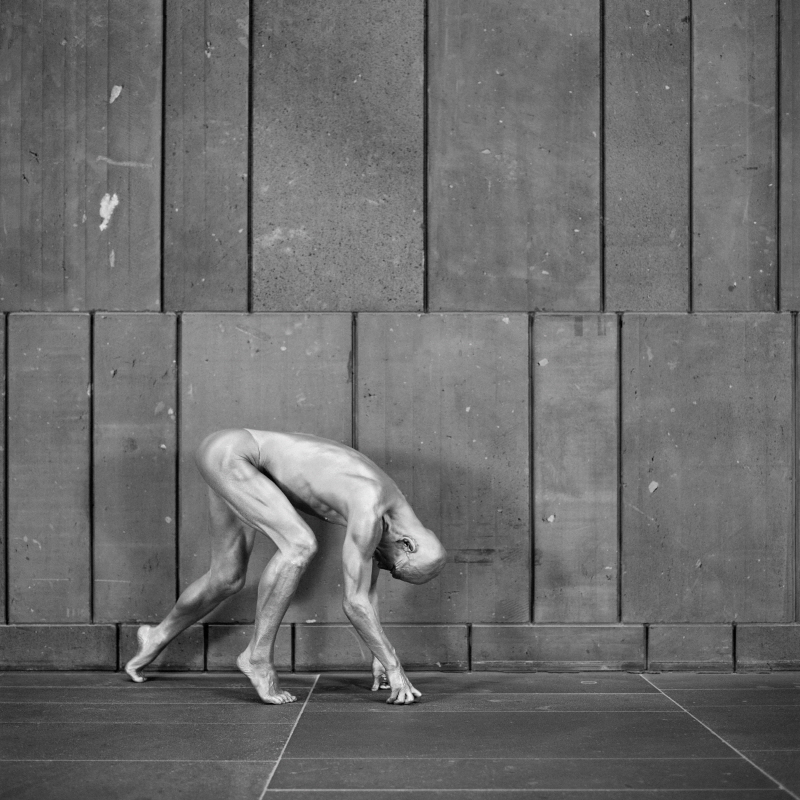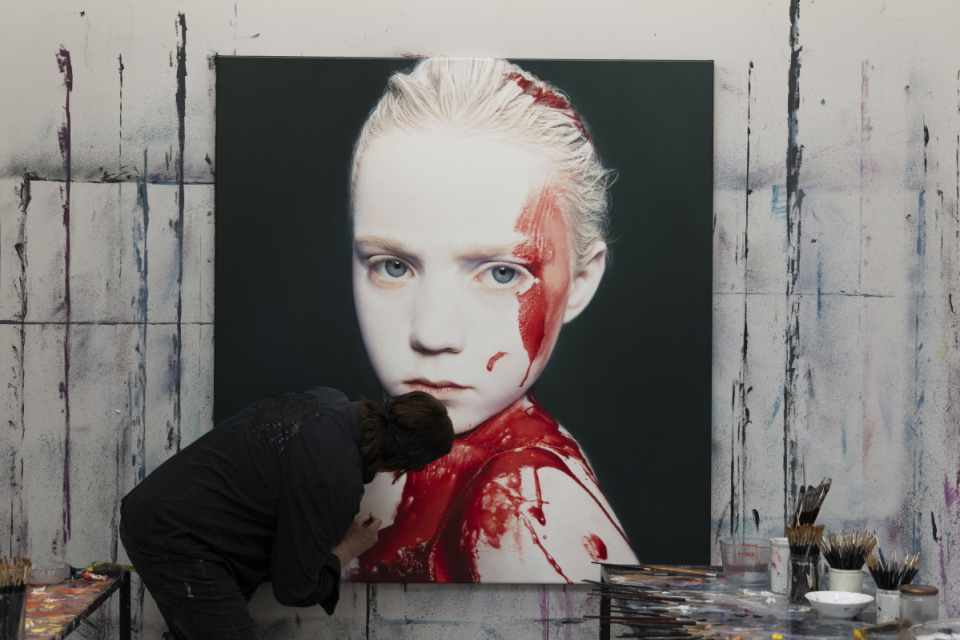[더프리뷰=오스트리아 밀슈타트] 안드레아 K. 슐레바인 안무가/문화기획자 = 일본 무용인 부토(정식 명칭은 ‘안고쿠 부토‘로 ‘암흑의 춤‘을 의미)는 신체평가에 대한 척도들을 부정하며, 분류나 명명 가능한 시스템을 넘어 본질적으로 카오스적으로 존재하는 현실의 몸을 소환한다. 부토는 영혼 및 정신과 불가분의 관계에 있다고 여겨지는 신체가 내면에서 외부로 움직임을 통해, 즉 춤을 통해 스스로를 표현하는 미지의 능력이 있음을 자각케 하는 일상 속 공간을 창조한다.
부토의 훈련과 실행은 매우 다면적이며, 신체적으로나 정신적으로나 극도로 까다로운 일이다. 금욕수행, 비서구적 명상훈련, 그리고 자연 속 수도승들과의 수행은 후루카와 안즈 또는 (사진에 있는) 무로부시 고와 같은 무용수들에게 깊이 자리잡은 수행과제들이다. 이 두 사람은 유럽에서 가르치기 시작한 초기 몇 년간, 무용수들을 신체의 한계까지 몰아붙였다.
무로부시 고는 자신과 자신의 예술에 대해 명확히 표현했는데 이는 여기 언급된 많은 예술가들에게도 적용되는 것이다. 즉 ‘예술 속의 삶’으로서, 이는 자기 자신으로 존재한다는 근본적 과제인 것이다.

1960년대 초반, 일본의 기성체제에 대한 반발과 일본의 미국화에 대한 반발, 그리고 노(能)와 가부키의 엄격한 규범에 대한 저항으로 탄생한 부토는 일본의 무용과 공연 지형을 변화시켰을 뿐 아니라 사회정치적 전망과 예술 및 문화에 대한 관점까지도 변화시켰다.
이와 동시에 뉴욕에서는 관습과 금기를 깨는 또 다른 변화가 일어났다. 주로 오노 요코, 캐롤리 슈니먼, 발리 엑스포트와 같은 여성 예술가들로 대표되는 행위예술이 하나의 장르로 등장한 것이다. 실연(live action)의 일회성에 초점을 맞추어 자신의 몸을 전시(ex-position)하여 보게 하는 새로운 형태의 예술표현이었다. 이는 자연스레 액션 페인팅과 해프닝으로 이어졌다. 예를 들어 발리 엑스포트의 <탭 앤 터치 시네마(Tapp- und Tastkino>(1968)에서는 누드와 성애화된 몸, 여성의 몸 등을 사용하여 관객들이 작품과의 상호작용을 통해 충격을 느끼는 순간에 감정이 표출되도록 하였다.
이는 부모 세대가 제 2차 세계대전의 결과에 제대로 대처하지 못한 데 반발하여 나타난 빈 액셔니즘(Viennese Actionism)에서도 비슷했다. 액셔니스트들은 이에 저항, 고함을 치며 전통, 순응주의, 계층적 사회구조 등과 실질적으로 단절했다. 사회와 예술에 대한 고착된 견해에 대해 근본적인 의문이 제기되었고 정치, 예술에 대한 쇄신이 요구되었다. 오토 뮐, 루돌프 슈바르츠코글러, 그리고 전설적인 작품 <한계 시험(Zerreißprobe>(1970)이 대표작인 귄터 브루스, 2022년 세상을 떠날 때까지 미스터리 연극을 지속한 헤르만 니취와 같은 빈 액셔니즘 창시자들은 자신의 몸을 사용한 자해와 같은 극단적 묘사를 통해 예술활동을 펼쳤다. 물론 자해행위는 일정 정도 내에서만 이루어졌지만 관객들이 보인 정서적 반응은 예상을 빗나가지 않았고 신체에 대한 문화적 이미지와 사회의 자아인식은 크게 흔들렸다.
가상의 신체에 대한 동시대 담론의 최전선에서 활동중인 오스트리아의 세계적 예술가 발리 엑스포트는 충격을 주는 것만이 반드시 예술의 구성요소가 될 필요는 없음을 보여준다.
오스트리아 안무가인 플로렌티나 홀찡어에게 있어 의도적으로 계획된 탄탄한 드라마투르기를 지닌 연극이란 헤르만 니취의 ‘주지육림 미스테리 연극(The Mysteries and Orgies Theatre)'과는 다른 의미를 지닌다. 니취의 작품에서는 배설물과 피를 헤치며 공격성과 충동을 표현하는 것이 신체적 가능성에 대한 인식과정이 되며 감각의 경계가 달라지는 것을 의미하게 되는데 이는 결국 참여자들의 자기치료적이고 카타르시스적인 효과를 목표로 한다. 문제는 우리 사회가 정말로 “경험의 강렬함....공격성과 잔인함이 주는 신비주의”를 필요로 하는가 하는 것인데, 우리의 실제 인식이 어떻든간에 현재 벌어지고 있는 전쟁들을 고려해 볼 때 그에 대한 대답은 여전히 나오지 않고 있다.
현재 베를린 로자 룩셈부르크 광장의 폴크스뷔네 극장 상주 안무가로 활동 중인 플로렌티나 홀찡어는 스펙터클과 무용, 전문 스턴트 사이를 오가는 도발적 무대작품을 통해 흥분과 스플래터, 가짜 피로 흥건한 매쉬업으로 이루어진 고차원의 예술을 지배하고 있다. 나체로 오토바이를 타는 여성, 피가 튀는 액션 페인팅, 무대에서 벌어지는 섹스와 배설 등 의도적으로 연출된 무대를 통해 전통적인 신체 이미지에 대해 교묘하게 의문을 제기하고 이를 정밀하게 해체한다. 수년간 여성들만 출연하고 있는 이 작품에서 퍼포머들의 신체 내부는 내시경을 통해 넓은 면적으로 투사된다. 신체 내부에서 일어나는 일을 눈으로 보게 되면서 관객들은 인식의 혼란을 일으킨다. 홀찡어는 종종 빈 액셔니즘과 비슷한 선상에 놓이기도 하지만 -비교해 볼 수도 있고 꼭 그럴 필요도 없지만- 그녀는 연극이란 단지 연출된 행위를 보여주는 장소일 뿐이며 여러 영역들 사이의 타협일 뿐이라고 간단히 말한다. 또한 신체예술가로서 자신에 대해 주관적으로 이야기하자면, 신체 내부의 공간도 외부 공간과 마찬가지로 볼 가치가 있고 말한다. 이는 신체 이미지를 해방시키고 재구성(reassign)을 시도한다는 뜻으로, 주목하고 시도해 볼만한 접근법이다.

팔크 리히터와 아누크 반 다이크 듀오는 팬데믹 기간이던 2020년 제작된 영리하면서도 감동적인 무대작품 <터치 touch>(2022년 뮌헨 캄머슈필 극장에서 재공연)에서 기존의 신체상과 이상적인 아름다움에 대해 관능적이고 시적인 방식으로 의문을 제기하는 데에 성공했다. 페미니즘, 젠더, 다양성에 대한 논쟁이 벌어지는 개화된 사회에서는 이제 정형화된 기준에 부합하지 않는다고 불이익을 받는 신체(장애가 있는 신체처럼)를 포함해 모든 종류의 신체가 실재하며 아름답다는 것을 보여주고 이해할 때가 되었다. <터치>는 현대무용에서 강력한 남성 트리오의 정점을 보여주는 작품이다. 즉, 진실하고 상대를 존중하며 평등하게 대하는 태도, 그리고 모든 형태의 신체는 그 안에 거하는 인간존재의 고향이라는 생각을 통해 우리는 한 사람의 개인이자 무용예술가로서 우리 스스로의 주권을 어떠한 의문도 없이 인정받아야 하는 것이다.

한 가지 신체, 한 가지의 순응적(관용적) 아름다움만 있는 것은 아니다. 신체에는 내면과 외면이 있으며 그 외면에는 또 다른 외면과 내면이 있어, 모든 신체는 항상 변화를 겪고 있는 ‘관계-속-존재’이며 이는 어떤 다른 예술보다도 찰나의 예술인 무용에서 분명하게 드러난다.
마찬가지로 고트프리트 헬른바인의 그림도 1970년대부터 파란을 일으키고 있으며, 정지된 이미지조차도 정지 상태에서 그저 가만히 있는 것이 아니라 내면의 삶 속에서 진동하고 있음을 보여준다. 극도로 미학적이며 결코 무미건조한 뉘앙스를 주는 법이 없는 그의 그림은 보는 이의 내면의 정서적 지각을 강화시켜 그림이 우리에게 말을 거는 의도가 무엇인지를(여기서는 정면을 응시하는 어린아이를 통해) 이해하게 된다. 즉 육체의 취약함과 연약함, 인간존재의 유한성 등이다.

신체예술은 그 내재적 측면과 외상(外象, 事象, phenomena) 사이를 오가며 존재한다. 이는 서로 접촉하며 유토피아적 맥락화 과정에서 스스로를 유동적으로(transmutably)으로 정의함으로써 자신을 영속적으로 재정의한다. 그 작동 반경은 다층적이며 멀티 미디어, 초국적인 것, 트랜스젠더 및 사회정치적 인식 사이의 통제할 수 없는 상호작용을 통해 고동치며 틀에 얽매이지 않고 존재한다. 신체의 변화 가능성과 삶의 상황에 대한 인식은 개인이 생각하는 가능성의 범위를 뛰어넘는 것이다.
(번역 김지유, 교열 더프리뷰)
Streifzüge (Wanderings / Forays / Expeditions), Radical Body Images
The Japanese dance form Butoh (actually Angoku Butoh, Dance of Darkness) negates evaluation criteria about the body and refers to a real body that is chaotic in nature and beyond classifications and namable systems. Butoh deals with creating space in daily practice for the awareness that the body, seen as inseparable from spirit and soul, carries within itself the capacity for the unknown, which articulates itself in the direction of movement from the inside to the outside, as dance.
Trainings and practices are multifaceted and extremely demanding with regard to body and psyche. Ascetic practices, exercises in non-Western-style meditation and research with monks in nature form a challenge that profoundly shaped dancers like Anzu Furukawa or Ko Murobushi (pictured here), and in the early years, when both began teaching in Europe, pushed Western dancers to the limits of their physical capabilities.
Ko Murobushi expressed for himself and his art what is true for many of the artists mentioned here: a life in art as the radical task of staying with oneself.
Originating in the 1960's as a rebellion against the establishment, the Americanization of Japan, and simultaneously as a revolt against the strict canons of No Theater and Kabuki, Butoh changed not only the dance and performance landscape of Japan, but also socio-political perspectives and the views on art and culture.
At the same time, another break with conventions and taboos occurred in New York. Performance art appeared as a genre with often female representatives such as Yoko Ono, Carolee Schneemann, VALIE EXPORT and others. A new form of artistic expression that focussed on the uniqueness of live action and brought the ex-position of one's own body into view. Transitions to action painting and happenings were fluid. Nudity and the sexualized, female body, for instance in VALIE EXPORT's <Tapp- und Tastkino>(1968), were employed to force the interacting audience to express their feelings by means of a shock moment.
Similarly, in Viennese Actionism, which rebelled against the failure of the parents' generation to adequately process the consequences of World War II. The Actionists shouted against and effectively broke with tradition, conformism and hierarchical-social structures. The rigid understanding of art and society was radically questioned; political and art-relevant renewal was demanded. The founders Otto Mühl, Rudolf Schwarzkogler, Günter Brus – such as in his legendary <Zerreißprobe>(1970) – and Hermann Nitsch – in his Mysteries Theatre that was held beyond the artist's death in 2022 – brought their own body into the focus of their extreme actions with depictions of self-injury. The self-attacks were within bounds, but the emotional reactions of the audience did not miss their mark, they profoundly shook the cultural self-image of the body and the self-perception of society.
The fact that the act of shocking does not have to remain the only feature constituting art is shown by the artist VALIE EXPORT who continues to act at the cutting edge with contemporary discourses about the virtual body and ranks among the most important Austrian artists worldwide.
What is deliberately shaped and dramaturgically solid theatre for the Austrian choreographerFlorentina Holzinger has a different intention in Hermann Nitsch's Mysteries and Orgies Theatre. In Nitsch's work, the physical action of the participants, the digging in feces and blood, the acting out of aggression and urges serves the process of becoming aware of physical capabilities and the shifting of sensual borders, which ultimately aims at a self-therapeutic, cathartic effect for the participants. The question if our society really needs an “intensity of experience (…) a mysticism of aggression and cruelty”, considering the existing wars, whether perceived or repressed, remains to be answered.
Florentina Holzinger, by now resident choreographer at the Volksbühne am Rosa-Luxemburg-Platz in Berlin, in her provocative stage works that oscillate between spectacle, dance and skilful stunts, masters the high art of agitation, splattering and wild mashup full of artificial blood. With naked women on motorbikes, bloody action painting, sex and excrements on stage, traditional body images are skillfully questioned and dismantled precisely because they are deliberately staged. Body interiors of the performers, whofor years have been exclusively female, are endoscopically decoded and projected on big surfaces. The view of internal physical processes is opened and creates perceptual confusion in the audience. Holzinger, who is often placed in the vicinity of the Viennese Actionists – a permissible but unnecessary throwback – rather laconically remarks that theater is, after all, a place of staged play and the negotiation of boundaries. Speaking for herself subjectively and as a body artist, the inside spaces of the body are just as worth seeing as its outside spaces. A remarkable and worthwhile approach that emancipates body images and seeks to reassign them.
In their clever and moving stage work touch, developed during the pandemic in 2020 (and restaged at Kammerspiele Munich December 2022), the directors duo Falk Richter and Anouk van Dijk succeed in questioning existing body images and beauty ideals in a contemporary and sensual-poetical way. In an enlightened society that is busy with feminism, gender and diversity, it is finally time to show and understand all forms of the body, including the disadvantaged, non-conforming – as in anatomically crippled – body, as existent and beautiful. touch culminates in one of the strongest male trios in contemporary dance: sincere, with respectful equal treatment, and in the knowledge that every body forms the home of the human being residing in it, who should be able to experience an unquestioned recognition of his or her sovereignty as an individual and as a dance artist.
There is not just one body, one conforming beauty. There is an inside and an outside and another outside and inside on the outside, a constant, dynamic being-put-in-relation of all bodies, something that in no art form is as clear as it is in the ephemeral art of dance.
Likewise, Gottfried Helnwein's paintings have been stirring us since the 1970s and shown that even a still image is by no means immobile in its static location, instead having a vibrant inner life. Hyperaesthetically painted, never aseptically nuanced, his images intensify sensations in the emotional interior of their viewer, from where the scope of what speaks to us – here exemplified by the direct gaze of the child – becomes comprehensible: the physical vulnerability and fragility, the finiteness of human existence.
The art of bodies oscillates between its immanent facets and phenomena. It touches, defines itself transmutably in utopian contextualization and thus permanently redefines itself. Its range of action is multilayered and stands unconventionally and vibrantly in uncontrollable interaction with multimedia, transnational, transgender and socio-political perception ; aware of the changeability of body and life situations, far beyond one's own space of possibilities.
Text by Andrea K. Schlehwein
Status AKS 03 01 2023
First published in abridged form: Die Brücke n° 34, Klagenfurt, Austria 2023
English translation of the unabridged text: Roman Zotter
Korean translation of the unabridged text: Jiyu Kim


